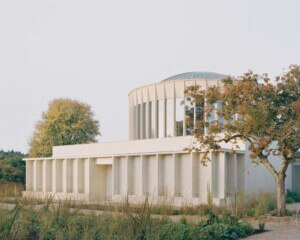| Brought to you by: |
Built to withstand extreme weather conditions, the alpine pod explores new frontiers for prefabricated architecture
Climbers on the Freboudze glacier can now take refuge from the punishing terrain of the Italian Alps thanks to a new prefabricated shelter commissioned by Italian alpine club CAI Torino. The New Gervasutti Refuge, which cantilevers from the rocky landscape in front of the east face of the Mont Blanc Range’s Grandes Jorasses, was designed and fabricated by LEAPfactory, an Italian firm specializing in modular structures with low environmental impact.
- Fabricator LEAPfactory
- Designer LEAPfactory
- Location Courmayeur, Italy
- Status Complete
- Materials Vinyl ester epoxy based matrix, E glass unidirectional fibers, PVC cores, polyurethane paints
- Process Finite element analysis, resin molding, helicopter installation
LEAPfactory, whose name stands for Living, Ecological, Alpine Pod, began designing the shelter in 2009. Its construction bears little resemblance to that of traditional alpine structures; instead, LEAP used nautical and aeronautical fabrication techniques to create a self-sufficient pod that could withstand extreme high-altitude conditions. The team used finite element analysis to apply wind loads of up to 124 miles/hour and snow loads more than 26 feet deep, while keeping in mind the weight of furnishings and occupants inside.
The structure’s primary components were prefabricated by infusing glass-fiber reinforced plastic (GFRP) into female molds with PVC cores. These pieces are glued together with methyl methacrylate-based adhesives. Luca Olivari, the project’s structural engineer, applied his expertise in designing boats and high-speed train components to the Gervasutti Refuge project. In a Q&A with Composites and Architecture, a blog by composite fabrication expert Bill Kreysler, Olivari said GFRP is an ideal material for extreme conditions because the fiber’s weight and orientation can be precisely defined in every area of the structure to support high concentrated loads. “The sandwich construction is the best way to absorb and distribute elastically the stresses of the wind gusts and the snow weight,” he said. Additionally, the components were strong and stiff enough to be transported by helicopter to the mountainside site.
The shelter is designed for strength outside, but its high-visibility pattern, reminiscent of a classic ski sweater, is meant to welcome mountaineers—as are its interiors. Lit with daylight through a panoramic, anti-scratch acrylic window overlooking the valley below, the 250-square-foot pod has kitchen, dining and living areas, twelve bunks and storage space for gear, as well as a built-in weather monitoring station. Photovoltaic panels integrated into the hut’s outer shell produce 2.5 Kwh of solar energy. The entire structure weighs almost 3 tons and cost the equivalent of nearly $327,000.
With individual modules designed for specific functions like eating or sleeping, LEAP’s design allows the pod to be rearranged or expanded over time. The design also allows for replacement of one module should it be seriously damaged. As the LEAPfactory team studies how their first installed shelter withstands conditions in its new home, they will be making plans to deploy similar helicopter-delivered structures in other mountainous locations—a reward for anyone willing to make the trip on foot.










